Transcatheter Valve Program Overview
Thank you for choosing the Transcatheter Heart Program at Good Samaritan Hospital. Our Active International Heart and Vascular Institute provides a highly trained and experienced team in the minimally invasive management of cardiac valve disease and aortic disease.
We are the first and only facility in Rockland and Orange counties to offer transcatheter aortic valve replacement (TAVR) for severe aortic stenosis.
Your Heart Team
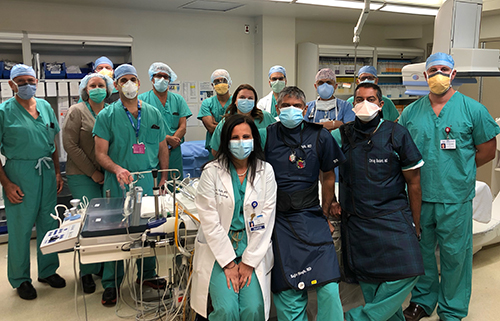
From your first consultation through your follow-up care, you will have a team of highly skilled and experienced cardiovascular specialists caring for you. Your heart team consists of cardiac surgeons, interventional cardiologists, electrophysiologists and cardiac imaging specialists.
Members of the team are experts in the field who routinely speak around the world about minimally invasive valve techniques. Our team has particular expertise in treating very high-risk patients.
As part of your consultation the entire team meets and discusses your specific history, tests, studies and ultimately creates a management plan that the team believes will be safe and effective at managing your particular issue.
If you or a loved one have aortic stenosis and are interested in finding out if TAVR is the right option for you, please speak with your cardiologist or call (845) 368.8800 to schedule a consultation.
Is TAVR right for you?
Learn more by selecting the following information:
About Aortic Stenosis
What is aortic stenosis? .jpg)
Aortic stenosis is the most common problem of the aortic valve. The aortic valve is the top-most valve in the heart before all the blood in the heart is pumped to the body. “Stenosis” means narrowing. Thus, with aortic stenosis the aortic valve becomes narrowed, forcing the heart to pump blood to the body through a smaller opening. As this narrowing progresses, this can cause a number of symptoms including shortness of breath, fatigue, chest pain or dizziness, and even fainting spells. Without treatment, aortic stenosis will cause heart failure and ultimately death. There are no medicines or lifestyle changes that can effectively treat aortic stenosis. The only effective treatment is valve replacement.
What are the symptoms of aortic stenosis?
Aortic stenosis develops very gradually over the course of many years. As a result, the heart does a good job of compensating for the progressive narrowing of the valve. Thus, patients with aortic stenosis often have no symptoms until the valve becomes extremely narrowed. Symptoms include chest discomfort (angina), light-headedness, fainting (syncope), and shortness of breath, fatigue or heart failure. Because the aortic stenosis develops slowly the symptoms can be very subtle at first, causing many patients to say,”I am fatigued or short of breath because I am old or out of shape.” If you experience these symptoms and signs you should consult your doctor urgently to determine the severity of your condition.
How is aortic stenosis diagnosed?
The first step is a thorough history and physical examination by your family doctor. Presence of symptoms, and a heart murmur heard with the stethoscope over the aortic valve area typically leads to an echocardiogram. This is a simple, painless and non-invasive test that uses ultrasound waves to look at the heart and the valves to assess whether or not someone might have aortic stenosis. The opening area of the aortic valve can be measured during the echocardiogram to better quantify the degree and severity of aortic stenosis. This is usually classified as mild, moderate or severe. This procedure is usually done in a physician’s office or imaging office.
Aortic stenosis can also be diagnosed by performing a cardiac catheterization. This procedure is performed in a hospital by an interventional cardiologist. Small catheters are placed through the artery in the leg or from the wrist and threaded up to the heart to measure the degree of narrowing of the aortic valve.
What is the current treatment of severe aortic stenosis?
If your aortic valve is severely narrowed, your doctor will discuss options with you. There are no medications that can halt or slow down the progression of aortic stenosis. If you do not have symptoms with heart function is still good, then close observation may be adequate. However, your doctor may perform a stress test which can often elicit hidden symptoms, such as fatigue. If you have symptoms, you need an urgent consultation with your doctor.
What if I don’t want anything done for my aortic stenosis?
There is no medical treatment for aortic stenosis. If you have mild or moderate aortic stenosis you can follow up with your doctor and he or she will advise you what to do. However, if you have severe aortic stenosis and symptoms, you need to seek urgent medical attention. In cases where individuals cannot undergo surgery or TAVR, the less effective and short term fix of balloon aortic valvuloplasty (BAV) may be another option.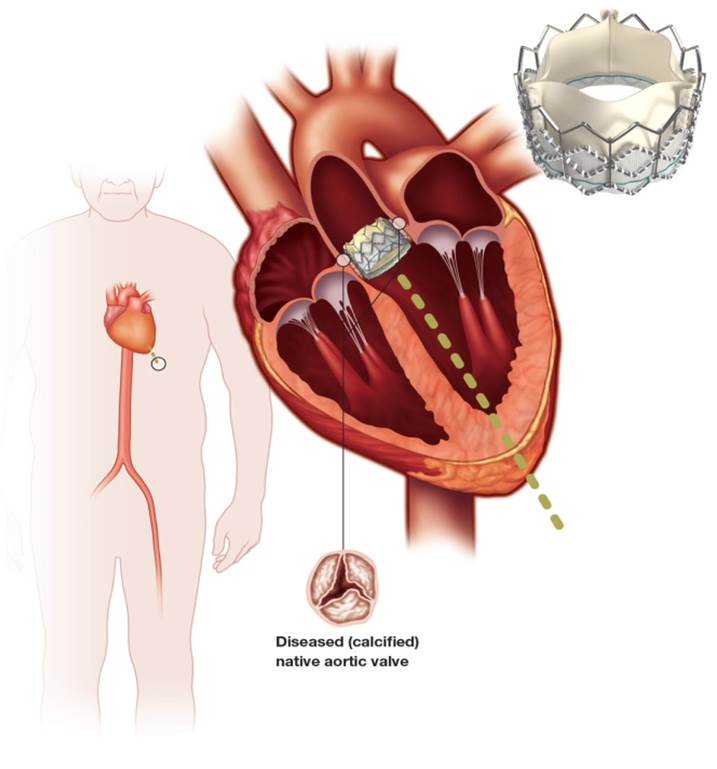
Minimally Invasive Aortic Valve Replacement with TAVR
There are currently two treatment options for severe aortic stenosis. The first option involves the replacement of the valve by open heart surgery, a procedure called surgical aortic valve replacement (SAVR). The second option involves replacing the aortic valve using a special expandable valve avoiding open heart surgery. This procedure is often abbreviated TAVR (Transcatheter Aortic Valve Replacement) or TAVI (Transcatheter Aortic Valve Implantation).
Good Samaritan Hospital is proud to be the only hospital to offer this service in Rockland and Orange counties.
How TAVR is performed at Good Samaritan Hospital
TAVR is most commonly performed through a needle stick or an incision in the groin that is less than one-inch long. In the rare case that it is not possible to perform the procedure through the groin, alternative access via the arm, neck or upper chest may be used. Our thorough preoperative evaluation will determine which approach is safest for each patient. Most procedures are performed under sedation, which maximizes patient comfort and speeds up recovery by avoiding general anesthesia. The procedure itself typically takes less than two hours and the typical hospital stay is one to two nights.
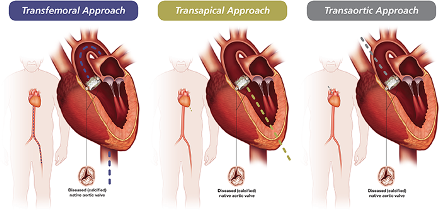
What sets Good Samaritan Hospital’s Transcatheter Heart Program apart?
Three things set us apart from other TAVR programs: excellence, accessibility, and convenience.
EXCELLENCE: Good Samaritan Hospital’s TAVR program has been built on WMCHealth’s renowned cardiology and cardiac program. Our cardiothoracic surgery team has delivered exceptional outcomes for surgical aortic valve replacement (AVR) including in high risk patients. Our interventional cardiologists have also achieved high success rates in their specialties. Our cardiothoracic surgeons and interventional cardiologists have trained in transcatheter aortic valve replacement procedures at leading institutions, have a long history of working together and will bring their expertise to this innovative therapy with the ultimate objective of improving our patients' quality of life.
ACCESSIBILITY: Our optimal location in Rockland county and regional proximity to your home will positively impact the quality and effectiveness of this treatment option. This means shorter travel distances for patients and their families when they need to make office visits, come in for the procedure and follow-up. This significantly reduces the length of time you will wait to receive care.
CONVENIENCE: Our Transcatheter Heart Program location is a model of efficiency. Patients can have all their required preliminary testing completed in one location, very often on the same day. Free on-site parking is also available to our patients and their families. Good Samaritan Hospital is pleased to be among a select few hospitals to offer TAVR in New York.
How effective is TAVR?
Studies have shown that TAVR is as effective as surgical AVR in moderate to high risk patients and is better than medication in prohibitive risk patients who are considered too high risk for open heart surgery.
What are some benefits I can expect to feel after I recover from a TAVR procedure?
You should start to feel increasingly better as you recover. This is because your heart valve is now working properly. Some patients may take longer to feel better. Many TAVR patients report benefits like:
- Having more energy
- Being able to do everyday activities
- Breathing normally
- Experiencing less pain
- Feeling less anxious
How will TAVR benefit residents of Rockland, Orange and Northern Bergen Counties?
Prior to Good Samaritan Hospital’s new Transcatheter Heart Program, this treatment was not available in the area. Patients no longer have to worry about traveling far from home to have the TAVR procedure done. Being closer to home will make scheduling appointments easier and your follow-up with your cardiac surgeon and cardiology team will be much more convenient.
Videos: Edwards SAPIEN Transcatheter Heart Valve
Transfemoral Deployment of Edwards Sapien Transcatheter Heart Valve in Calcified Aortic Valve
Transfemoral deployment of heart valve during TAVR procedure at Westchester Medical Center.
Transfemoral deployment of the Medtronic CoreValve in TAVR
What to Expect: TAVR Process at Good Samaritan Hospital and Frequently Asked Questions
What kind of tests or pre-testing will I need to go through to be considered for TAVR?
To be considered for TAVR, you will visit us at our Transcatheter Heart Program location in Suffern, NY where our heart team will assess your current health condition and medical history and determine if you are an ideal candidate for the TAVR procedure. After that, you will undergo a series of lab and imaging tests.
How long does the TAVR procedure take?
The TAVR procedure itself takes approximately 2 hours, but will require additional time to get you prepared; placement of monitoring lines, anesthetic induction and room setup.
Will I be awake for the procedure?
TAVR can be done under general anesthesia or local anesthesia with IV sedation. We have found patients who had local anesthesia recover faster and go home more quickly. Our team including anesthesiologists will discuss and recommend the best option for you.
Will I be able to go home on the same day after the procedure?
You will not go home on the same day of the transcatheter aortic valve replacement procedure.
How long is the hospital stay?
The hospital stay, on average, is approximately 2-7 days. However, some patients might recover more quickly and be eligible for discharge in 1-3 days.
If I’m selected for the procedure, how will I know if my health insurance will cover TAVR?
Our billing specialists will work with the Transcatheter Heart Program team to determine your insurance coverage for the procedure.
How long will the recovery process be after the TAVR procedure?
After discharge from the hospital, it takes on average 2-3 weeks to fully recover from TAVR. Our patients are expected to be able to walk about unassisted 1 - 2 days after the procedure. Some patients will be eligible to return home following the procedure and the required hospital stay. Other patients might benefit from additional rehabilitation services after the procedure either as an inpatient or outpatient. Our team of social workers at the Transcatheter Heart Program will work closely with you and your family to determine the best course for you.
What kind of follow-up will I need?
TAVR patients will participate in a comprehensive follow-up program to ensure full-recovery and an improved quality of life. A component of the follow-up program will be incorporated into the national Transcatheter Valvular Therapy (TVT) database. Your first follow-up visit with us after the TAVR procedure will be 4 weeks, then 6 months and 12 months, or earlier if necessary.
How long does the transcatheter valve last in TAVR?
Studies have shown the valves to be durable over 5 years with some data suggesting over 10 years. Rarely patients have returned for a repeat procedure due to transcatheter valve failure. Even so, there are now minimally invasive and catheter options to address a failing transcatheter valve.
What is the age limit to be a candidate for TAVR?
There is no age limit for TAVR. The majority of TAVR patients are in their late 70’s to 100s.
Can I request the TAVR procedure even if I’m a candidate for traditional open chest surgery but not high risk?
TAVR is now approved for patients with lesser degrees of risk for open surgery. You or your doctor may request an evaluation for the TAVR procedure. The TAVR team will determine which procedure is best for you.
I have other medical issues in addition to aortic stenosis, how will that affect whether or not I am eligible for the procedure?
Our Transcatheter Heart Program team includes multidisciplinary specialists, such as internists, endocrinologists, neurologists, renal (kidney) specialists, nutritionists and social workers who work together with our cardiologists and cardiothoracic surgeons. Together our team will assess your medical history and existing health condition to determine your eligibility for the TAVR procedure. A part of our comprehensive approach to your care includes the involvement of medical specialists who collaborate to ensure a treatment plan specific to your needs and current health. Our team will, for example, consider existing conditions such as diabetes, liver or kidney problems, and any other existing health problems you might have--in addition to aortic stenosis when planning your treatment course.
Success Stories
Select a patient story below to learn more about their experience with Good Samaritan Hospital's Cardiac Care
_____________________________________________________________________________________________________________________________
Testimonial: Elizabeth and James Mooney
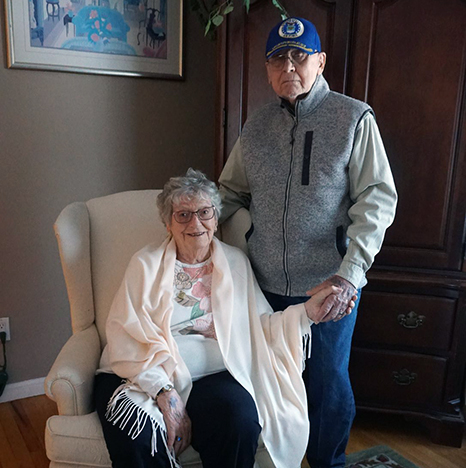
Elizabeth and James Mooney, both in their 90s, have been married for almost 66 years and share four children, 11 grandchildren and seven great grandchildren. They have shared long, healthy lives and have been enjoying retirement in Florida for the past 12 years, returning to New York frequently to visit their son and daughter.
Recently, the pair started experiencing increasing fatigue and shortness of breath and underwent echocardiograms and stress tests in the care of Cary Hirsch, MD, Co-Director of the Active International Cardiovascular Institute at Good Samaritan Hospital, a member of the Westchester Medical Center Health Network.
The tests determined that both Mooneys had coronary disease and their valves had to be replaced. Dr. Hirsch recommended that they both have the TAVR (Transcatheter Aortic Valve Replacement) procedure, adding the minimally invasive procedure to the long list of everything the couple has shared together.
TAVR is a minimally invasive approach that enables the replacement of a diseased aortic valve through the use of very small incisions. It can result in less discomfort for the patient, shorter hospital stays, quicker recovery and fewer post-procedure restrictions than traditional, open-heart surgery. Their procedures were performed by cardiac surgeon, Chirag Badami, MD, and interventional cardiologists Rajiv Singh, MD and Yoram Amsalem, MD.
After her surgery in November, Mrs. Mooney said: “I got up and walked around the next day and went out for lunch!” Now, she’s attending physical therapy and they both celebrated Valentine’s Day together, although they’re anxious to get back to Florida.
“I don’t like the snow!” said Mr. Mooney.
Watch their segment on News 12
Testimonial: Kevin Meagher
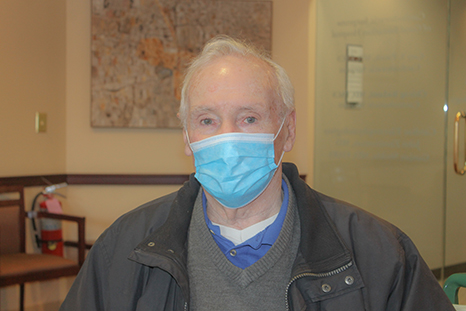
Kevin Meagher, 90, has been a resident of Suffern, NY, for over 50 years. His journey with Good Samaritan Hospital began in 2017, when he experienced a heart attack that caused a dangerously low heart rate and severe leaking of his mitral valve. In the ED, Meagher met cardiologist, Rajiv Singh, MD, who is a part of the Good Samaritan Hospital HeartSTAT program. Through this program he immediately underwent emergency stenting of multiple blocked arteries. The leaking of his mitral valve was successfully resolved, and he went home with a full recovery.
Meagher continued as an outpatient with Dr. Singh, with close monitoring of his coronary arteries, stents and heart valves. “I felt very confident with Dr. Singh, he was always very thorough and took the time to explain things to me,” said Meagher.
During the COVID pandemic, Meagher noticed that he experiencing shortness of breath when walking or playing golf. Dr. Singh performed an ultrasound of his heart, confirming that Meagher had a calcified aortic valve that had trouble opening, called stenosis. He recommended a valve replacement.
Fortunately for Meagher, the Transcatheter Aortic Valve Replacement (TAVR) Program at Good Samaritan Hospital had recently been introduced. TAVR is a minimally-invasive approach that enables the replacement of a diseased aortic valve through the use of very small incisions. It can result in less discomfort for the patient, shorter hospital stays, quicker recovery and fewer post-procedure restrictions than traditional, open-heart surgery. Meagher was living independently and walking freely prior to his valve symptoms, making him an excellent candidate for TAVR.
In addition to Dr. Singh, Meagher’s TAVR team included cardiothoracic surgeons, Cary Passik, MD, FACS, and Chirag Badami MD, FACS, imaging specialists, anesthesiologists, cardiac nurses and a valve nurse coordinator.
Meagher successfully underwent the TAVR procedure without complication, and was surprised how quickly he recovered. “I had the surgery on a Monday and I could not believe I was headed home on Tuesday! I was able to take a walk around the recovery room and I felt an immediate difference. I thought I would feel weaker, but I was able to get back to all of my old activities,” said Meagher.
Meagher was very impressed with the staff at Good Samaritan Hospital and would recommend the TAVR procedure to anyone experiencing the debilitating symptoms of aortic stenosis. In addition to spending time with his family, he is looking forward to getting back on the golf course this spring!
>> Read More Success Stories
Testimonial: Marcella Franks
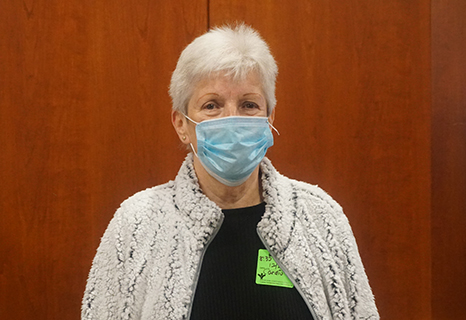
Marcella Franks, 77, of Port Jervis, NY, likes to stay active and despite officially retiring 13 years ago, she continues to work part-time as a Production Supervisor at Kolmar Labs. Her job keeps her busy and she is always on her feet, so when she started to experience increased fatigue and shortness of breath early this fall, she went to her primary care provider and cardiologist, Walter Kaufmann, MD of the Bon Secours Medical Group. Dr. Kaufmann recommended she have an echocardiogram at Bon Secours Community Hospital and the results showed that her heart value needed replacing.
As part of the collaborative network of quality care, Dr. Kauffman referred Franks to fellow Bon Secours Medical Group cardiologist, Rajiv Singh, MD, who is part of the new Transcatheter Aortic Valve Replacement (TAVR) Program at Good Samaritan Hospital in Suffern, NY. Franks was excited to hear about the minimally invasive valve replacement solution and was impressed during her first consultation with Dr. Singh.
“Dr. Singh took the time to sit down and walk me through the entire TAVR procedure. He gave helpful examples and showed me specific images of what to expect. It was like talking to a close friend. His demeanor and expertise eliminated the fear of the unknown and made me confident I was making the right choice. Dr. Singh and the team at Good Samaritan Hospital went the extra mile and researched a custom solution that was tailored to my exact heart valve,” said Franks.
TAVR is a minimally-invasive approach that enables the replacement of a diseased aortic valve through the use of very small incisions. It can result in less discomfort for the patient, shorter hospital stays, quicker recovery and fewer post-procedure restrictions than traditional, open-heart surgery.
In addition to Dr. Singh, Franks’ TAVR team included cardiothoracic surgeons, Cary Passik, MD, FACS, and Chirag Badami MD, FACS, imaging specialists, anesthesiologists, cardiac nurses and a valve nurse coordinator.
Franks successfully underwent the TAVR procedure without complication. “I was able to go home the very next day after my TAVR. I do not believe I would have recovered as quickly or as well as I have had it not been for the positive energy of the entire Good Samaritan Hospital staff. The team is incredibly professional, compassionate and personal. Suzanne Bartman, BSN, RN, CCRN, the valve nurse coordinator, was with me every step of the way. She is a wonderful resource,” said Franks. In addition to spending time with her family, Franks is enjoying taking long walks and bike rides with friends again!
>> Read More Success Stories
- Thoracic and Cardiac Surgery
- General Surgery
- Thoracic and Cardiac Surgery
- Internal Medicine, Interventional Cardiology
- Echocardiography
- Internal Medicine, Nuclear Cardiology